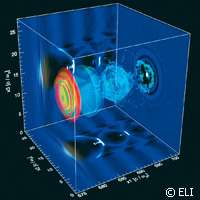Super lasers in Europe? You bet

Gaining and maintaining a strong foothold in the European and global technology markets is high on the EU agenda. Helping meet this goal is the ELI ('Extreme light infrastructure') project, which clinched EUR 6 million under the Research Infrastructures budget line of the EU's Seventh Framework Programme (FP7) to build a laser of intensity sufficient to rip photons into electron-positron pairs.
A total of four initial high-powered lasers will be built in eastern Europe; three will be built initially, with the fourth one scheduled for a later date. The first super laser, to be located near the Czech capital city of Prague, will achieve exawatt class, making it around 100 times more powerful than what is currently available.
The project partners point out that ELI's primary goal is to serve as a research tool. This type of super laser could play a crucial role in the development of new cancer diagnosis and treatments, and could help fuel our understanding of molecular biology and nanoscience. It could also be used to resolve myriad issues that weigh heavily on the minds of environmentalists, like how to handle nuclear waste.
Sources in the Czech Republic are quoted as saying that the ELI laser was a tough deal to get since five countries were pushing to bring it to their part of the world.
The Czech Republic, however, will become a strong player in the field of optic and photonic research thanks to the ELI project. In the last decade, this EU Member State has hosted Precision Automated Laser Signals (PALS), which is one of the most sophisticated laser systems across Europe.
Under the plan, the super laser will start running within the next four years in Dolni Brezany, a town located south of Prague. It will operate using very short pulses of significantly high-energy particle and radiation beams.
Hungary and Romania are set to be the next locations for the super lasers. Sources say that each project will specialise in diverse research areas. But all projects will lead to the construction of the fourth super laser, which will have double the power of the three lasers. This fourth super laser will yield up to 200 petawatts per hour, which experts say is the theoretical limit for lasers.
Sources say the project's overall price tag will total EUR 700 million. ELI brings together almost 40 research and academic institutions from 13 EU Member States. Coordinated by the Centre National de la Recherche Scientifique in France, ELI comprises three branches: 1) ultra-high field science that explores laser-matter interaction in an energy range where relativistic laws could become null and void; 2) attosecond laser science, which is designed to conduct a temporal investigation of electron dynamics in atoms, molecules, plasmas and solids at the attosecond scale; and 3) high-energy beam science that focuses on the development and use of dedicated beam lines with ultra short pulses of high-energy radiation and pulses reaching nearly the speed of light.
Experts from Bulgaria, the Czech Republic, Germany, Greece, Spain, France, Italy, Lithuania, Hungary, Poland, Portugal, Romania and the United Kingdom are making major contributions to this project.
More information: www.extreme-light-infrastructure.eu/
Provided by CORDIS



















